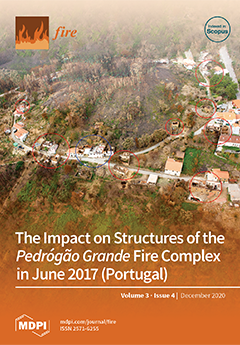Understanding the mechanisms underlying tree spatial arrangements may provide significant insights into the processes in the maintenance of species coexistence. We examined the potential role of habitat heterogeneity, dispersal limitation, negative density dependence, fire history, and unilateral intraspecific and interspecific interactions of adults
[...] Read more.
Understanding the mechanisms underlying tree spatial arrangements may provide significant insights into the processes in the maintenance of species coexistence. We examined the potential role of habitat heterogeneity, dispersal limitation, negative density dependence, fire history, and unilateral intraspecific and interspecific interactions of adults on juveniles in shaping the spatial patterns of four dominant tree species (
Abies concolor,
Pinus lambertiana,
Calocedrus decurrens, and
Quercus kelloggii) after fire in the Yosemite Forest Dynamic Plot, California, USA. We used the univariate pair correlation function and implemented three point pattern processes (homogeneous Poisson process, inhomogeneous Poisson process, and homogeneous Thomas process) to evaluate the potential contributions of habitat filtering and dispersal limitation. We used a bivariate null model to evaluate unilateral intraspecific and interspecific interactions of adults on juveniles. We also used the pairwise correlation function to investigate the spatial patterns of density dependence. To understand the effect of fire, we used the univariate pair correlation function to investigate pattern changes during the six years following fire. We compared spatial pattern changes in both sprouting species (
Quercus kelloggii) and seeding species (
Abies concolor), and also examined the changes in patterns of large-diameter individuals of
Abies concolor,
Pinus lambertiana, and
Calocedrus decurrens in 2013 (pre-fire), 2016 (two years post-fire), and 2019. Comparing the contributions of the homogeneous Thomas process and the inhomogeneous Poisson process at different spatial scales showed the importance of dispersal limitation and habitat heterogeneity at finer scales (0 m to 5 m) and coarser scales (5 m to 60 m), respectively, which suggests that the joint effects of dispersal limitation and habitat heterogeneity contribute to the spatial patterns of these three dominant tree species. Furthermore, the results showed that the young individuals of
Abies concolor and
Pinus lambertiana were more commonly found around the conspecific adults. Juvenile regeneration to the 1 cm diameter threshold was highly aggregated following the fire. Large-diameter trees of
Abies concolor,
Pinus lambertiana, and
Calocedrus decurrens generally did not exhibit patterns different from complete spatial randomness (
Calocedrus decurrens), or displayed only slight aggregation (
Abies concolor and
Pinus lambertiana). In addition,
Abies concolor and
Pinus lambertiana showed positive and negative conspecific density dependence in the immediate post-fire period, respectively.
Full article





